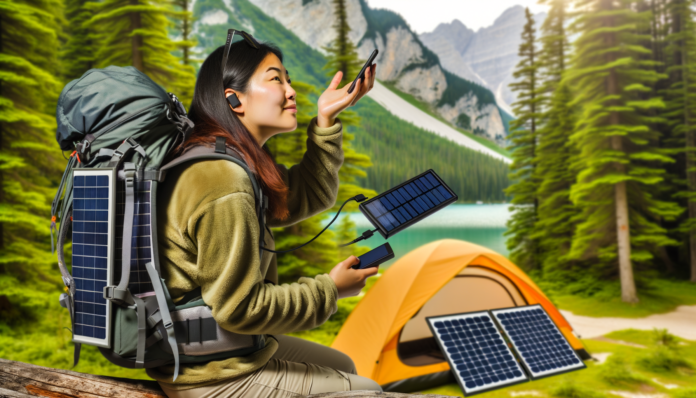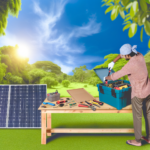Introduction
Overview of Outdoor Adventures and Solar Gear
Outdoor adventures, whether they involve hiking, camping, or extended road trips, offer a unique opportunity to connect with nature and escape the hustle and bustle of daily life. However, these activities often require reliable sources of power for various needs, such as lighting, cooking, and charging electronic devices. Traditionally, adventurers have relied on batteries or fuel-based generators, but these options can be cumbersome, environmentally unfriendly, and costly over time.
Enter solar gear—a game-changer for outdoor enthusiasts. Solar gear encompasses a range of products designed to harness the sun’s energy and convert it into usable power. From portable solar panels and solar-powered lanterns to solar chargers and even solar cookers, these devices offer a sustainable and efficient way to meet energy needs while on the go. By leveraging the power of the sun, adventurers can enjoy greater independence, reduce their environmental footprint, and potentially save money in the long run.
Purpose of the Article
The primary aim of this article is to provide a comprehensive cost-benefit analysis of using solar gear for outdoor adventures. We will delve into the various types of solar gear available, how they work, and their common applications in outdoor settings. By examining both the benefits and costs associated with solar gear, we aim to offer a balanced perspective that will help you make informed decisions about incorporating these technologies into your outdoor activities.
Specifically, this article will:
- Explain the different types of solar gear and their functionalities.
- Highlight the environmental, financial, and practical benefits of using solar gear.
- Discuss the initial investment, maintenance, and potential hidden costs associated with solar gear.
- Provide a detailed cost-benefit analysis to help you weigh the pros and cons.
- Offer practical tips for maximizing the efficiency and lifespan of your solar gear.
Target Audience
This article is tailored for a diverse audience, including:
- Outdoor Enthusiasts: Individuals who frequently engage in activities like hiking, camping, and road trips and are looking for sustainable and efficient ways to power their adventures.
- Eco-Conscious Consumers: People who are committed to reducing their environmental impact and are interested in adopting green technologies.
- Cost-Conscious Adventurers: Those who are keen on finding cost-effective solutions for their energy needs while enjoying the great outdoors.
- Tech-Savvy Individuals: Early adopters of new technologies who are curious about the latest advancements in solar gear and how they can be applied in real-world scenarios.
By the end of this article, you will have a thorough understanding of the advantages and disadvantages of using solar gear for outdoor adventures, enabling you to make well-informed decisions that align with your needs and values.
Understanding Solar Gear
Types of Solar Gear
Solar gear encompasses a wide range of devices designed to harness the sun’s energy for various uses. Here are some common types:
- Solar Panels: These are the most recognizable form of solar gear, used to convert sunlight into electricity. They can be installed on rooftops, ground mounts, or even integrated into structures like pergolas.
- Solar Chargers: Portable devices that can charge batteries for phones, cameras, and other small electronics. They are ideal for camping and hiking.
- Solar Lights: These include garden lights, pathway lights, and even solar-powered lanterns, providing illumination without the need for electrical wiring.
- Solar Cookers: Devices that use reflective surfaces to concentrate sunlight for cooking food, perfect for outdoor adventures where traditional cooking methods are impractical.
- Solar Water Heaters: Systems that use solar energy to heat water, which can be used for showers, washing dishes, or even heating pools.
How Solar Gear Works
Solar gear operates on the principle of converting sunlight into usable energy, typically through photovoltaic (PV) cells. Here’s a simplified breakdown of the process:
- Absorption of Sunlight: Solar panels or cells absorb photons from sunlight.
- Generation of Electric Current: The absorbed photons knock electrons loose from their atoms, generating a flow of electricity. This process occurs within the PV cells, which are made of semiconductor materials like silicon.
- Conversion to Usable Power: The direct current (DC) electricity generated by the PV cells is converted into alternating current (AC) by an inverter, making it compatible with most household appliances and devices.
- Storage and Use: The electricity can be used immediately, stored in batteries for later use, or fed back into the electrical grid, depending on the system setup.
Common Uses in Outdoor Activities
Solar gear is incredibly versatile and can enhance a variety of outdoor activities by providing reliable, renewable energy. Here are some common applications:
- Camping: Solar chargers and portable solar panels can keep your devices powered, while solar lights and cookers can make your campsite more comfortable and functional.
- Hiking: Lightweight solar chargers can be attached to backpacks to charge devices on the go, ensuring you have power for GPS units, phones, and cameras.
- Boating: Solar panels can be installed on boats to power navigation systems, lights, and other essential equipment, reducing reliance on fuel-powered generators.
- Backyard Activities: Solar pergolas and lights can create a pleasant and sustainable outdoor living space, perfect for gatherings and relaxation.
- Emergency Preparedness: Solar gear can provide critical power during emergencies when traditional power sources are unavailable, making it a valuable addition to any emergency kit.
By understanding the types of solar gear available, how they work, and their practical applications, outdoor enthusiasts can make informed decisions to enhance their adventures while promoting sustainability.
Benefits of Using Solar Gear
Environmental Impact
One of the most compelling benefits of using solar gear for outdoor adventures is its positive environmental impact. Solar energy is a clean, renewable resource that significantly reduces carbon footprints. Unlike traditional fossil fuels, solar power generates electricity without emitting greenhouse gases or other pollutants. This means that by using solar gear, such as solar panels, chargers, and lights, you are contributing to a reduction in air pollution and helping to combat climate change. Additionally, solar gear often has a longer lifespan compared to conventional batteries, which reduces waste and the need for frequent replacements.
Cost Savings Over Time
While the initial investment in solar gear can be higher than traditional alternatives, the long-term cost savings are substantial. Once the solar equipment is purchased and installed, the energy it generates is free. This can lead to significant savings on fuel and battery costs over time. For instance, using a solar charger to power your devices eliminates the need to buy disposable batteries or pay for electricity to charge them. Over the years, these savings can add up, making solar gear a cost-effective solution for avid outdoor enthusiasts.
Convenience and Independence
Solar gear offers unparalleled convenience and independence, especially in remote locations where access to electricity is limited or non-existent. With solar-powered devices, you can enjoy extended outdoor adventures without worrying about running out of power. Solar chargers can keep your GPS, smartphone, and other essential gadgets operational, ensuring you stay connected and safe. Moreover, solar lights can illuminate your campsite without the need for fuel or batteries, providing a reliable source of light throughout the night. This level of self-sufficiency enhances the overall outdoor experience, allowing you to explore further and stay longer.
Durability and Reliability
Modern solar gear is designed to be durable and reliable, making it well-suited for the rigors of outdoor use. Many solar panels and chargers are built to withstand harsh weather conditions, including rain, snow, and extreme temperatures. They are often constructed with rugged materials that can endure physical impacts and rough handling. This durability ensures that your solar gear will continue to function effectively even in challenging environments. Additionally, solar technology has advanced to the point where it can reliably generate power even on cloudy days, providing a consistent energy source regardless of the weather.
In summary, the benefits of using solar gear for outdoor adventures are multifaceted. From reducing environmental impact and saving costs over time to offering convenience, independence, and reliability, solar gear enhances the outdoor experience in numerous ways. By investing in solar technology, you not only support sustainable practices but also ensure that your adventures are powered by a clean and renewable energy source.
Costs Associated with Solar Gear
Initial Investment
The initial investment in solar gear can be substantial, but it is a critical step towards sustainable and independent outdoor adventures. The cost of solar panels, solar chargers, and other related equipment varies widely based on quality, efficiency, and brand. For instance, the Jackery SolarSaga 100, a popular choice among campers, offers a balance of efficiency and affordability, priced around $300. On the other hand, high-end models like the Renogy 100W Foldable, known for its durability and performance in all weather conditions, can cost upwards of $400.
When considering the initial investment, it’s essential to evaluate the power output and portability of the solar gear. Lightweight and foldable options, such as the BioLite Solar Panel 100, are ideal for backpacking but may come at a higher price due to their compact design and convenience. Additionally, some solar panels come with integrated features like USB ports and built-in handles, which can add to the cost but enhance usability.
Maintenance and Upkeep
Maintenance and upkeep of solar gear are relatively minimal compared to other power sources, but they are still important to ensure longevity and efficiency. Regular cleaning of the solar panels is necessary to remove dust, dirt, and debris that can obstruct sunlight and reduce power output. This can typically be done with a soft cloth and mild detergent.
Inspecting the gear for any physical damage, such as cracks or loose connections, is also crucial. Most solar panels are designed to be durable and weather-resistant, but exposure to harsh conditions can still cause wear and tear over time. For instance, the EcoFlow 110 is known for its waterproof design, which reduces maintenance concerns in wet conditions.
Battery maintenance is another aspect to consider. If your solar setup includes a battery storage system, such as those found in portable power stations, it’s important to follow the manufacturer’s guidelines for charging and storage to prolong battery life. Some batteries may require periodic calibration or firmware updates, which can be done through the manufacturer’s app or service centers.
Potential Hidden Costs
While the primary costs of purchasing and maintaining solar gear are straightforward, there are potential hidden costs that users should be aware of. One such cost is the need for additional accessories or adapters. For example, the EcoFlow 110 requires a separate charging cable, which is not included in the initial purchase. These additional components can add to the overall expense.
Another hidden cost is the potential need for replacement parts. Although solar panels are built to last, components like cables, connectors, and even the panels themselves may need replacement after extended use. Ensuring that you have access to compatible replacement parts and understanding their costs can help you budget more effectively.
Lastly, consider the cost of potential upgrades. As technology advances, newer and more efficient solar gear becomes available. Upgrading to the latest models can provide better performance and additional features but will also require further investment. For instance, upgrading from a basic solar panel to a model with integrated battery storage or higher wattage output can significantly enhance your setup but at a higher cost.
In conclusion, while the initial investment in solar gear can be high, the long-term benefits of reduced maintenance, environmental impact, and independence make it a worthwhile consideration for outdoor enthusiasts. Being aware of the potential hidden costs and planning for maintenance can help maximize the value and efficiency of your solar gear.
Cost-Benefit Analysis
Comparing Initial Costs to Long-Term Savings
Investing in solar gear for outdoor adventures often involves a significant initial outlay. The cost of solar panels, portable solar chargers, and other solar-powered devices can be higher than their non-solar counterparts. However, this initial investment can be offset by long-term savings.
**Initial Costs:**
– **Solar Panels:** High-quality portable solar panels can range from $100 to $500 or more, depending on their capacity and efficiency.
– **Solar Chargers:** Portable solar chargers typically cost between $20 and $100.
– **Solar-Powered Gadgets:** Items like solar lanterns, cookers, and water purifiers can add to the initial expense.
**Long-Term Savings:**
– **Reduced Energy Costs:** By harnessing free solar energy, you can significantly reduce or eliminate the need for batteries and fuel, which are recurring expenses.
– **Durability:** Solar gear is often built to last, reducing the need for frequent replacements.
– **Maintenance:** Solar devices generally require minimal maintenance, further lowering long-term costs.
In essence, while the upfront costs may be higher, the long-term savings on energy and maintenance can make solar gear a cost-effective choice for outdoor enthusiasts.
Evaluating Environmental Benefits
One of the most compelling reasons to invest in solar gear is its positive environmental impact. Traditional energy sources, such as disposable batteries and fossil fuels, contribute to pollution and environmental degradation. In contrast, solar energy is a clean, renewable resource.
**Environmental Benefits:**
– **Reduced Carbon Footprint:** Using solar gear reduces reliance on fossil fuels, thereby lowering greenhouse gas emissions.
– **Less Waste:** Solar-powered devices reduce the need for disposable batteries, which are harmful to the environment when not disposed of properly.
– **Sustainable Energy:** Solar energy is renewable and abundant, making it a sustainable choice for powering outdoor adventures.
By choosing solar gear, outdoor enthusiasts can enjoy their activities while minimizing their environmental impact, contributing to a healthier planet.
Assessing Convenience and Practicality
Solar gear offers a level of convenience and practicality that traditional energy sources often cannot match. This is particularly true for outdoor adventures where access to conventional power sources is limited.
**Convenience:**
– **Portability:** Many solar devices are designed to be lightweight and portable, making them easy to carry on hikes, camping trips, and other outdoor activities.
– **Independence:** Solar gear allows you to be self-sufficient, providing power in remote locations without the need for external power sources.
– **Ease of Use:** Modern solar devices are user-friendly, often requiring minimal setup and maintenance.
**Practicality:**
– **Reliability:** Solar gear is generally reliable, with fewer moving parts that can break down compared to traditional generators.
– **Versatility:** Solar panels and chargers can power a wide range of devices, from smartphones to camping lights, making them versatile tools for any outdoor adventure.
– **Safety:** Solar-powered devices eliminate the risks associated with fuel-based equipment, such as fire hazards and toxic fumes.
In summary, the convenience and practicality of solar gear make it an attractive option for outdoor enthusiasts looking to enhance their adventures while staying eco-friendly and self-sufficient.
Practical Tips for Maximizing Solar Gear Use
Choosing the Right Solar Gear for Your Needs
Selecting the appropriate solar gear is crucial for maximizing your outdoor adventures. Here are some key considerations:
- Purpose: Identify what you need to power. Are you charging small devices like phones and cameras, or do you need to run larger equipment like portable fridges and lights?
- Portability: For hiking and camping, lightweight and foldable solar panels are ideal. For RVs or base camps, larger, more robust panels may be suitable.
- Efficiency: Look for high-efficiency panels, such as monocrystalline panels with PERC (Passivated Emitter and Rear Cell) technology, which offer better performance in limited space.
- Durability: Ensure the gear is rugged and weather-resistant to withstand outdoor conditions.
Proper Setup and Installation
Setting up your solar gear correctly is essential for optimal performance:
- Optimal Placement: Position your solar panels to face the sun directly. In the Northern Hemisphere, this means facing true south, and in the Southern Hemisphere, true north. Adjust the tilt angle to match your latitude for maximum sunlight absorption.
- Avoid Shading: Ensure there are no obstructions like trees or tents casting shadows on the panels, as even partial shading can significantly reduce efficiency.
- Secure Mounting: Use sturdy mounts to keep the panels stable, especially in windy conditions. For portable setups, ensure the panels are securely placed to avoid damage.
Maintenance Tips
Regular maintenance ensures your solar gear remains efficient and extends its lifespan:
- Cleaning: Keep the panels clean from dust, dirt, and debris. Use a soft cloth and mild soapy water to clean the surface, and avoid harsh chemicals that could damage the panels.
- Inspection: Regularly inspect the panels and connections for any signs of wear or damage. Look for cracks, loose wires, or corrosion, and address any issues promptly.
- Storage: When not in use, store your solar gear in a cool, dry place. Protect the panels from physical damage and extreme temperatures.
Troubleshooting Common Issues
Even with proper care, you may encounter some issues with your solar gear. Here are common problems and solutions:
- Low Power Output: Check for shading, dirt on the panels, or improper angle. Ensure all connections are secure and the battery is functioning correctly.
- Intermittent Power: Inspect the wiring and connectors for any loose or damaged parts. Ensure the charge controller is working properly.
- Battery Issues: If the battery isn’t holding a charge, it may be time to replace it. Ensure you are using a compatible battery type and that it is properly connected.
- Overheating: Ensure the panels have adequate ventilation and are not exposed to extreme heat for prolonged periods. Overheating can reduce efficiency and damage the panels.
By following these practical tips, you can maximize the efficiency and longevity of your solar gear, ensuring a reliable and sustainable power source for all your outdoor adventures.
Conclusion
Summary of Key Points
In this article, we have explored the multifaceted benefits and costs associated with using solar gear for outdoor adventures. We began by understanding the different types of solar gear available and how they function. We then delved into the numerous benefits, including environmental impact, cost savings over time, convenience, and durability. On the flip side, we also examined the initial investment, maintenance, and potential hidden costs associated with solar gear. A comprehensive cost-benefit analysis was conducted to weigh these factors against each other. Finally, practical tips were provided to help you maximize the use of your solar gear, from choosing the right equipment to proper maintenance and troubleshooting.
Final Thoughts on Solar Gear for Outdoor Adventures
Solar gear has revolutionized the way we approach outdoor adventures, offering a sustainable and reliable source of energy that aligns with the growing emphasis on environmental responsibility. The initial investment may seem daunting, but the long-term benefits—both financial and ecological—make it a worthwhile consideration. The convenience of having a portable, renewable energy source cannot be overstated, especially for those who frequently venture into remote areas. Moreover, the durability and reliability of modern solar gear ensure that it can withstand the rigors of outdoor use, providing peace of mind and consistent performance.
Encouragement to Embrace Sustainable Solutions
As we continue to face the challenges of climate change and environmental degradation, embracing sustainable solutions like solar gear becomes not just an option but a necessity. By integrating solar technology into our outdoor adventures, we not only reduce our carbon footprint but also set an example for others to follow. The shift towards renewable energy sources is a collective effort, and every small step counts. Whether you are an avid camper, a weekend hiker, or someone who enjoys the occasional outdoor excursion, investing in solar gear is a practical and impactful way to contribute to a more sustainable future. So, take the plunge, make the investment, and enjoy the myriad benefits that come with harnessing the power of the sun.






